EOC 10 inch 40 caliber
| EOC 10 inch 40 caliber | |
|---|---|
|
Twin gun turret of an Ammiraglio di Saint Bon-class battleship | |
| Type | Naval gun |
| Place of origin | United Kingdom |
| Service history | |
| In service | 1895–1945 |
| Used by |
Argentine Navy Imperial Japanese Navy Regia Marina Spanish Navy |
| Wars |
Russo-Japanese War Italo-Turkish War World War I |
| Production history | |
| Designer | Elswick Ordnance Company |
| Designed | 1893 |
| Manufacturer |
Elswick Ordnance Company Stabilimenti meccanici di Pozzuoli Kure Naval Arsenal |
| Produced | 1893 |
| Variants |
Pattern P Pattern P1 Pattern R Cannone da 254/40 A 1893 Cannone da 254/40 A 1899 10 inch 40 caliber Type 41 25 cm 40 caliber Type 41 |
| Specifications | |
| Weight | 30.5 long tons (31.0 t) |
| Length | 34.6 ft (10.5 m) |
| Barrel length | 33.3 ft (10.1 m) 40 caliber |
|
| |
| Shell | Separate-loading 85.7 lb (38.9 kg) bagged ballistite charge |
| Shell weight | 480–500 lb (220–230 kg) |
| Caliber | 10.0 inches (254 mm) |
| Elevation | -5° to +20° |
| Traverse | -80° to +80° |
| Rate of fire | About 1.5 rounds per minute |
| Muzzle velocity | 2,460 ft/s (750 m/s)[1] |
| Maximum firing range | 11.2 mi (18.0 km) at +20°[2] |
The EOC 10 inch 40 caliber guns were a family of related guns designed by the Elswick Ordnance Company and produced by Armstrong Whitworth in the 1890s for export customers. EOC 10 inch 40 caliber guns were the primary armament of Armored Cruisers, Ironclads and Pre-dreadnought Battleships built or refit during the 1890's. These guns and their licensed derivatives armed ships of the Argentine Navy, Imperial Japanese Navy, Regia Marina and Spanish Navy. They served in the Russo-Japanese War, Italo-Turkish War and World War I.
History
Development of the 10 inch 40 caliber guns began in the early 1890's at the Elswick Ordnance Company located at Newcastle upon Tyne, England. They were developed for export customers and had the EOC designations of Pattern P, Pattern P1 and Pattern R. They were built-up guns with an A tube and reinforced with two rows of hoops. Originally they had a semi-automatic screw breech mechanism, which opened the breech as the gun recoiled. However, this was found unsatisfactory and was replaced by a hand worked breech.[1]
The Italian designation for the EOC 10 inch guns was Cannone da 254/40 A Modello 1893 and Cannone da 254/40 A Modello 1899. The Modello 1893 version was a trunnion-less gun, while the Modello 1899 had trunnions. Italian single gun mounts were electrically powered, while twin mounts were hydraulically powered. In addition to guns imported from England licensed versions were produced by the Stabilimenti meccanici di Pozzuoli (Armstrong factory) at Pozzuoli, Italy.[3]
In 1908 the Japanese designated EOC 10 inch guns as 10 inch 40 caliber Type 41. Later in 1917, they were re-designated in centimeter as 25 cm 40 caliber Type 41. In addition to guns imported from England and Italy, four licensed versions were produced at the Kure Naval Arsenal beginning in 1908. The Kure guns differed from their English and Italian counterparts by using different rifling.[4]
Naval Use
Argentine Navy
- Giuseppe Garibaldi-class cruisers - Three of the four ships of this class purchased by Argentina had a primary armament of two Pattern P guns in single gun turrets fore and aft of the superstructure.[5]
Italian Navy
- Ammiraglio di Saint Bon-class battleships - The two ships of this class had a primary armament of four 254/40 A guns in twin turrets fore and aft of the superstructure. Both ships saw action during the Italo-Turkish War.[6]
- Giuseppe Garibaldi-class cruisers - The three ships of this class purchased by Italy had a mixed primary armament of one 254/40 A gun in a single turret fore and two EOC 8 inch 45 caliber guns in a twin turret aft of the superstructure. All three ships saw action during the Italo-Turkish War and World War I.[7]
- Italian ironclad Enrico Dandolo - This ship had a primary armament of four 254/40 A guns in twin turrets en echelon amidships after a 1895-1898 refit.[8]
Japanese Navy
- Giuseppe Garibaldi-class cruisers - One of the two ships of this class purchased by Japan the Kasuga had a mixed primary armament of one Pattern R gun in a single turret fore and two EOC 8 inch 45 caliber guns in a twin turret aft of the superstructure. The other ship the Nisshin had two EOC 8 inch 45 caliber guns in twin turrets fore and aft of the superstructure. Both ships participated in the Battle of the Yellow Sea and the Battle of Tsushima during the Russo-Japanese War.[9]
Spanish Navy
- Giuseppe Garibaldi-class cruisers - The single ship of this class purchased by Spain the Cristóbal Colón was designed to carry a single Pattern R gun in a turret fore and two 8-inch guns in a twin turret aft of the superstructure, but the Spanish Ministry of Marine rejected the 10-inch gun, so she had to rely on her two 8-inch guns and ten casemated 6-inch guns.[10] Cristóbal Colón was sunk at the battle of Battle of Santiago de Cuba during the Spanish-American War.[11]
Ammunition
Ammunition was of separate loading bagged charge and projectile type. The bagged ballistite charge weighed 85.7 lb (38.9 kg) and projectiles weighed between 480–500 lb (220–230 kg).
The gun was able to fire:
Photo Gallery
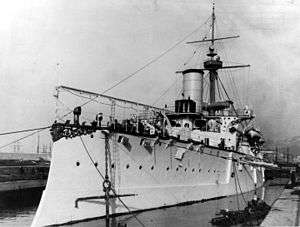 ARA Garibaldi
ARA Garibaldi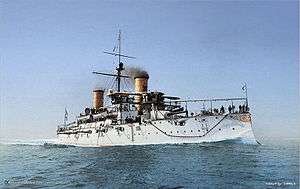 ARA General Belgrano
ARA General Belgrano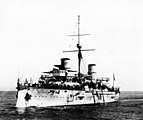 ARA Pueyrredon
ARA Pueyrredon Top view of a twin 10-inch gun turret
Top view of a twin 10-inch gun turret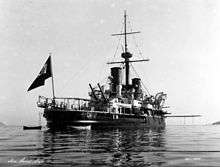 Stern view of the Ammiraglio di Saint Bon
Stern view of the Ammiraglio di Saint Bon Italian cruiser Giuseppe Garibaldi
Italian cruiser Giuseppe Garibaldi A Garibaldi class cruiser bombarding the Ottoman ironclad Avnillah in Beirut Harbor 24 February 1912.
A Garibaldi class cruiser bombarding the Ottoman ironclad Avnillah in Beirut Harbor 24 February 1912. The battleship Enrico Dandolo on 6 December 1898 after refit
The battleship Enrico Dandolo on 6 December 1898 after refit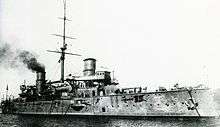 IJN Kasuga
IJN Kasuga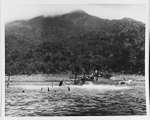 The wreck of Cristóbal Colón on 3 July 1898
The wreck of Cristóbal Colón on 3 July 1898
Footnotes
- 1 2 3 Friedman, Norman (2011). Naval weapons of World War One. S. Yorkshire: Seaforth Pub. p. 68. ISBN 9781848321007. OCLC 751804655.
- ↑ DiGiulian, Tony. "Italy 10"/40 (25.4 cm) EOC Pattern R - NavWeaps". www.navweaps.com. Retrieved 2017-08-12.
- ↑ Friedman, Norman (2011). Naval weapons of World War One. S. Yorkshire: Seaforth Pub. p. 235. ISBN 9781848321007. OCLC 751804655.
- ↑ Friedman, Norman (2011). Naval weapons of World War One : guns, torpedoes, mines and ASW weapons of all nations : an illustrated directory. S. Yorkshire: Seaforth Pub. pp. 273–274. ISBN 9781848321007. OCLC 751804655.
- ↑ "Garibaldi armoured cruisers (1896-1898) - Argentinean Navy (Argentina)". www.navypedia.org. Retrieved 2017-08-11.
- ↑ "AMMIRAGLIO DI SAINT BON battleships (1901 - 1902) - Regia Marina (Italy)". www.navypedia.org. Retrieved 2017-08-11.
- ↑ "Giuseppe Garibaldi armoured cruisers (1901 - 1905) - Regia Marina (Italy)". www.navypedia.org. Retrieved 2017-08-11.
- ↑ "DUILIO turret ships (1880 - 1882) - Regia Marina (Italy)". www.navypedia.org. Retrieved 2017-08-11.
- ↑ "Kasuga armoured cruisers (1904) - Imperial Japanese Navy (Japan)". www.navypedia.org. Retrieved 2017-08-11.
- ↑ McSherry, Patrick. "Cristobal Colon". www.spanamwar.com. Retrieved 2017-08-12.
- ↑ "Spanish cruiser Cristóbal Colón | laststandonzombieisland". laststandonzombieisland.com. Retrieved 2017-08-12.
References
- Campbell, John (1985). Naval Weapons of World War II. Annapolis, MD: Naval Institute Press. ISBN 0-87021-459-4.
- Friedman, Norman (2011). Naval Weapons of World War One. Barnsley, South Yorkshire, UK: Seaforth. ISBN 978-1-84832-100-7.
External links
- http://www.navweaps.com/Weapons/WNJAP_10-40_EOC.php
- http://www.historicaleye.it/pozzuoli-dai-cantieri-armstrong-alla-breda-sofer/
- http://oldbritishguns.com/elswick-ordnance-co
